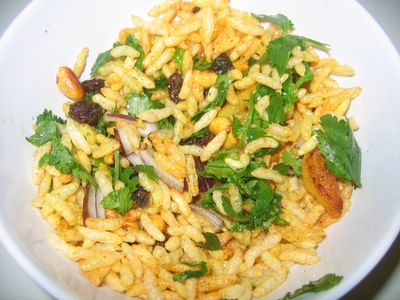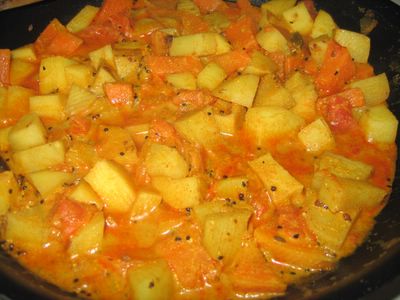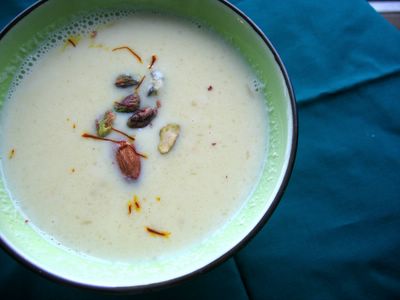We were loitering in the Milpitas area and we saw Thirupathi Bhimas, a restaurant in a non-descript mall. It was closed that day but we were attracted by the name 'Sri Krishna Sweets' that was before its name (Every Chennaite must know that Krishna Sweets mysore pa are delectable treats oozing with ghee). Now I also know that, it is a branch of Bhimas hotel in Thirupathi, AP. This is a place where we dine every time we visit the Lord Balaji temple.
So expecting to find them selling mysore pa, we walked in one Saturday afternoon. There were around 20 people waiting to be seated and that is always a good sign, isn't it? It was like a mini-Tamil Nadu in there. It felt good being there and hearing our language being spoken all around. Even the restaurant manager spoke in tamil.
We were disappointed that they just used the Krishna sweets name and they did not sell mysore pa. But, nevertheless we decided to have our meals there. And we did a good thing. They have a spicy Andhra thali (a four course meal served in a plate) that comes with Kara kuzhambu, a kurma and a kara curry. So being the spice lover, I chose it. My husband had their non-spicy thali (check out their site). All the dishes were of tamilian origin, it seemed. Even their Andhra thali... But for an array of condiments like paruppu podi, gongura pickle and avakkai pickle, you could not say there was anything related to AP. I was sort of disappointed by this because I was expecting some authentic Andhra food.
Andhra or tamil, the food was great. If you are used to a medium level of spiciness, you can order any of these two versions of thali. If you are looking for good tamil or rather south Indian food experience, you have to try this place out. In the evenings, they also serve dosa, vada and other south Indian tiffin items.
Tuesday, January 31, 2006
Monday, January 30, 2006
Weekend Cookbook challenge- Dal paratha

I have been waiting to participate in the Weekend cookbook challenge hosted by Sara and Alicat because the project involves something that is close to my heart-cookbooks and this month's theme is winter comfort foods. I am an arm-chair cook and I read more recipes than I ever cook. I own almost thirty cookbooks but my most used book is the 'Net' itself. I am glad to be taking part this month.
I grew up in the southern India where there is no winter. Winter brings with it some rare, foggy mornings but thats about it. But a bigger indication that winter is around is the availability of cauliflower, red carrots (also called Delhi carrots) and English peas. Pittsburgh winter was a big surprise (should I say shock?) to me when I came to the US.
Somehow, I always have a craving for parathas in winter. This recipe is from an Indian cookbook 'Roz ka khana' (translates to Everyday Food) by Tarla Dalal I have had for a couple of years.
Dal Paratha (makes 6)
For dough:
1 cup whole wheat flour
1 tsp oil
1/2 tsp salt
enough water
Knead the above well into a smooth, soft dough. Let rest for 30 min. Divide into six portions.
Filling:
1/2 cup moong dal, soaked for 20 min
1/2 tsp cumin seeds
1/2 tsp chili powder
a pinch of asafoetida (optional)
1/2 tsp turmeric
1 tsp garam masala
salt, to taste
1 T finely chopped cilantro
Cook moongdal in 1 cup water and turmeric until very tender and most of the water has been absorbed. Strain the dal and save the water for making the dough. Heat a saute pan. Add 1 tsp oil. Add cumin seeds and asafoetida. When cumin changes to a golden brown, add dal, chili powder, salt and garam masala. Saute till mixture dries up completely. Mix in cilantro. Divide into six portions.
To make parathas- Roll out one portion of dough into a small 4-inch disc. Place one portion of filling in center and bring in the corners of the disc and seal tightly. Dust lightly with flour and roll into a circle of 6 inches or so. The rolled paratha will be thicker than the usual chappathi. Cook on a medium-hot tava with some ghee or butter until both sides are golden brown.
I like to make a big batch of parathas and store it for a couple of days. It does not dry out like chappathis and it becomes soft and tasty when nuked.
Along with some yogurt and achaar, it is a great, balanced meal.
Tagged:Weekend cookbook challenge
Friday, January 20, 2006
Jhaal moori- Kolkata Street Food

My husband was in Kolkata for a few years and he loved being there. The one thing he misses and often raves about is the street food. Street food in Kolkata can be anything from dosa, to Chinese food to the usual chaat. We keep trying to make the famous Jhaal moori, a dry version of bhelpuri. Recently, a Bengali friend mentioned her way of making it. The key is to use mustard oil. But before you run to get a bottle, I warn you- mustard oil is an extreme food. It has a wasabi like kick when you use it raw like in this recipe. If you are not a Bangla, chances are you will not like it. But I am an exception and I like it. My husband, having lived on foods cooked with mustard oil for two years, hates it. So if you buy, get the smallest bottle you can find.
My friend has a solution too-if you don't want to buy mustard oil, use the oil that collects on top of Indian achaar. Simple enough...
Jhaal moori- for one
1 cup bhel
2 T sev
a sprinkling of finely chopped onion
1 green chili, finely chopped
1 T roasted peanuts
a sprinkling of chopped cilantro
a pinch of red chili powder
salt, as required
1 tsp of mustard oil or more to coat
a good squeeze of lemon juice
Mix and serve at once. It is easier to make individual portions and serve. In my experience, larger portions become too oily or get soggy before you eat it.
I used Nupur's Quick Bhadang and left out the sev. Bhadang is great on its own and this way it was even better. It is really worth making a lot of the bhadang and storing it up for eating as a snack, bhel puri or jhaal moori.
Wednesday, January 18, 2006
Latest Kitchenware acquisition-Madeleine pan

I have been looking for a silicone madeleine pan for a while. But I was not desperate enough to order online because my past forays into online shopping have increased my credit card bills significantly. I always buy more than required and at least for now, space is a premium in our apartment. When I visited the Great mall at Milpitas today, I saw a Farberware store and went in search of a madeleine pan. That was the first thing I saw inside the store. I bought it (for $12.99, dunno if it a good bargain or not) and I came rushing home to try Malgieri's recipe for chocolate-orange madeleines from his 'Chocolate' book (the recipe is almost similar to this).

The baked madeleines are delightfully tender and cake-like. The aroma from the beurre noisette is amazing. Some recipes call for just melting the butter but this will not give it flavor as much as the browned butter. The orange zest is a great addition, according to my husband who does not like much of chocolate desserts, can you believe it? I also came across Julie's scented madeleines that had been submitted for Paper chef. It sounds delicious with the almond paste and all. So that will be the star of my next madeleine making event.
Tuesday, January 17, 2006
Potato and red pumpkin curry- A Rajasthani delight

I have posted a recipe for something Indian after a while. The subzi is something I tasted when I ordered a Rajasthani thali (meal) a year back in New Jersey. This was the curry of the day and seriously, I thought it was a bad combination of vegetables. I was even contemplating that it was just leftover vegetables but that was before I tasted it. It tasted good and very flavorful. I found the same recipe in Tarla Dalal's Rajasthani cookbook. I did more than recreate restaurant flavors. It was delicious even though there is no garlic or onion in this dish and the spice-combination is very unique.
Red pumpkin is a bright-orange squash that is sold in Indian and Asian markets. If you don't find it, acorn squash will work well.
Aloo-Pethe ka saag (translates to the above)
4 medium red potatoes, peeled and cubed
3 cups of red pumpkin cubes (just peel and cut them into chunks)
2-3 T yogurt (since it involves a lot of cooking of the yogurt, it is better to use full-fat one)
spice bouquet:
1 tsp mustard seeds
1 tsp nigella or onion seeds
1/2 tsp fennel seeds
1/4 tsp fenugreek seeds
1 bay leaf
1 inch cinnamon bark
2 cardamom pods
2 cloves
1/4 tsp asafoetida
1 tomato, finely chopped
2 tsp coriander-cumin powder
1 tsp red chili powder
1/2 tsp turmeric
1 tsp amchur powder (dried mango powder)
1/2 tsp sugar (optional)
salt to taste
1. Heat a tbsp of oil or ghee and fry the spice bouquet until the seeds crackle. Add asafoetida, yogurt, chili powder, coriander-cumin powder and turmeric and fry for 2-3 min.
2. Add potato and pumpkin and 1/2 cup water, cover and cook on medium-low flame until vegetables are almost but not fully done. Add the tomato and salt and cover and cook until tender.
3. Lastly add amchur and sugar.
Monday, January 16, 2006
Dining around the Silicon Valley
We have been having a ball eating out in good Indian resturants. The quality of Indian food here is much better than what we have had in Pittsburgh. The huge Indian community here has to be given credit for this. Only the good places seem to survive here. Some of our friends have given restaurant reviews and we have gone to a few good places accordingly. Chaat Paradise, Mountain View is a well-liked place. We are chaat lovers and we were determined to visit this place.
We decided that our dinner will be all-chaat. I ordered their snack combo that comes with two chaat items, a papad and tea/coffee. I had the dahi batata sev puri and hara bhara bhel. You can even substitute the beverage with chasni or thinned down buttermilk spiced with cumin seeds. My husband ordered the bhelpuri and spicy misal (as an experiment). There is no difference between the two bhels except for the addition of cucumber in mine. The spicy misal is a pav bhaji type of dish served with toasted pav. The misal is a bhaji made of bean sprouts. I was not too impressed with it though. The dishes are quite spicy just as chaat should be.
When 20 month old Aditi refused to eat even a spoon of these dishes, we had to order some bread. I am not a fan of chapathis served at restaurants. So we ordered the makai di roti. It is a speciality of Punjab. It is an unleavened bread made with cornmeal and served with a lot of ghee. Aditi liked it with some raita. Overall nice chaats and fast service. Quite inexpensive, really.
We decided that our dinner will be all-chaat. I ordered their snack combo that comes with two chaat items, a papad and tea/coffee. I had the dahi batata sev puri and hara bhara bhel. You can even substitute the beverage with chasni or thinned down buttermilk spiced with cumin seeds. My husband ordered the bhelpuri and spicy misal (as an experiment). There is no difference between the two bhels except for the addition of cucumber in mine. The spicy misal is a pav bhaji type of dish served with toasted pav. The misal is a bhaji made of bean sprouts. I was not too impressed with it though. The dishes are quite spicy just as chaat should be.
When 20 month old Aditi refused to eat even a spoon of these dishes, we had to order some bread. I am not a fan of chapathis served at restaurants. So we ordered the makai di roti. It is a speciality of Punjab. It is an unleavened bread made with cornmeal and served with a lot of ghee. Aditi liked it with some raita. Overall nice chaats and fast service. Quite inexpensive, really.
Friday, January 06, 2006
Veggie chowmein-Indian style
I am looking out for a nice restaurant in San Jose that serves Indo-Chinese food. But till I find one, I have to make it at home even if stir-frying is a painful process when done in an apartment and with an electric stove.
Most Indians will attest to their love for Chinese food. But the dishes we so love belong to the hakka style, developed by Chinese immigrants to the easterm part of India. It is very much spicy and tongue-tingling, not even remotely similar to real Chinese food. Chowmein is only slightly spicy from green chili sauce and of course, there is a chicken version of this that I have seen in restaurants. Here is the recipe with no visual details.
1 package hakka noodles, cooked well in advance according to package directions
1 onion, diced into large chunks
1 cup roughly chopped cabbage
1/2 a large carrot, peeled and shredded into thin strips
a tbsp of finely diced celery
1 bell pepper, cut into strips
handful of bean sprouts
2 garlic cloves pounded coarsely with or without 2 dried red chilis
salt(optional- add if the salt from soy sauce is not enough for your taste)
sauce mixture:
2 T light soy sauce
1 T green chili sauce
1 T rice vinegar
1. Toss the drained, cooked noodles with little oil. Let it cool down completely.
2. Heat a tsp of oil in a wok and add the onion and let it cook for 30 sec or so. Next add the garlic paste and saute until it smells like nicely toasted garlic. Add oil periodically in 1/2 tsp additions, if needed. Otherwise, the fumes will have you coughing for a couple of hours (as I learned the hard way).
3. Add celery, bell pepper and carrot strips. Celery is used in most indo-chinese dishes but it is optional. Stir-fry until veggies are still crunchy and add salt if required . Lastly add the cabbage.
4. Add the noodles and let it heat up. Add bean sprouts. Lastly add the sauce mixture and toss well for a minute or two.
This is traditionally served with green chili rings soaked in vinegar and also some red and green chili sauce.
Most Indians will attest to their love for Chinese food. But the dishes we so love belong to the hakka style, developed by Chinese immigrants to the easterm part of India. It is very much spicy and tongue-tingling, not even remotely similar to real Chinese food. Chowmein is only slightly spicy from green chili sauce and of course, there is a chicken version of this that I have seen in restaurants. Here is the recipe with no visual details.
1 package hakka noodles, cooked well in advance according to package directions
1 onion, diced into large chunks
1 cup roughly chopped cabbage
1/2 a large carrot, peeled and shredded into thin strips
a tbsp of finely diced celery
1 bell pepper, cut into strips
handful of bean sprouts
2 garlic cloves pounded coarsely with or without 2 dried red chilis
salt(optional- add if the salt from soy sauce is not enough for your taste)
sauce mixture:
2 T light soy sauce
1 T green chili sauce
1 T rice vinegar
1. Toss the drained, cooked noodles with little oil. Let it cool down completely.
2. Heat a tsp of oil in a wok and add the onion and let it cook for 30 sec or so. Next add the garlic paste and saute until it smells like nicely toasted garlic. Add oil periodically in 1/2 tsp additions, if needed. Otherwise, the fumes will have you coughing for a couple of hours (as I learned the hard way).
3. Add celery, bell pepper and carrot strips. Celery is used in most indo-chinese dishes but it is optional. Stir-fry until veggies are still crunchy and add salt if required . Lastly add the cabbage.
4. Add the noodles and let it heat up. Add bean sprouts. Lastly add the sauce mixture and toss well for a minute or two.
This is traditionally served with green chili rings soaked in vinegar and also some red and green chili sauce.
Tuesday, January 03, 2006
Welcome 2006!
Happy new year to y'all! Hope this year enriches all our lives with health and happiness.
This is a fresh beginning for my family and a maiden post for this blog from the not-so-warm San Jose. See you all soon with a REAL post...
This is a fresh beginning for my family and a maiden post for this blog from the not-so-warm San Jose. See you all soon with a REAL post...
Subscribe to:
Comments (Atom)
